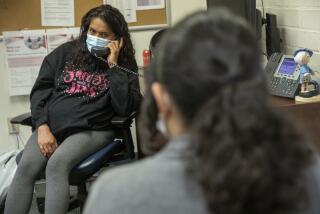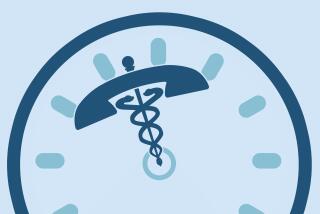Uninsured patients face long waits
- Share via
Adults with no health insurance face waits up to a year or longer for gallbladder or hernia surgery in Los Angeles County, a backlog that community clinic doctors say has worsened since the county downsized Martin Luther King Jr.-Harbor Hospital last year.
The elimination of most specialty care at King-Harbor, formerly known as King/Drew, has hit Harbor-UCLA Medical Center near Torrance the hardest, the doctors say. As the county-owned hospital closest to King-Harbor, it absorbed the bulk of that facility’s displaced patients.
Community clinics rely on five county-owned hospitals to provide virtually all specialty care, including hernia and gallbladder surgery, for their uninsured patients.
With a quarter of the county’s adult population lacking insurance, patients have always had to wait a long time. But delays are growing longer as the population ages and suffers complications from such chronic conditions as diabetes and obesity.
Still, clinic doctors were stunned earlier this month when Harbor-UCLA told them not to send any more nonemergency gallstone, hernia, orthopedic or neurosurgery patients until hospital physicians worked through the yearlong backlog for these surgeries.
After a Times reporter asked about the ban on referrals, the medical center sent another notice lifting it. But the backlog remains.
“The bottom line is there’s still a year’s wait,” said Dr. Karen Lamp, medical director for the Venice Family Clinic.
Lamp said she now refers such patients to specialists at two other county hospitals, Olive View-UCLA Medical Center in the San Fernando Valley or Los Angeles County-USC Medical Center northeast of downtown. But both have waiting lists of their own, and Lamp fears that they too will become overwhelmed.
The other alternative is to send patients to hospital emergency rooms. That’s what Dr. Rachna Gupta, chief medical officer for the South Bay Family Healthcare Center, did when a young man came to her Inglewood clinic doubled over in pain from an inflamed gallbladder.
“Emergency rooms should be saved for emergencies,” she said. “But no one has a better answer.”
More than a decade ago, the county partnered with nonprofit clinics to give the uninsured a place to go besides emergency rooms, which must see patients regardless of their ability to pay. Health officials also hoped that regular visits to primary care clinics would keep illnesses from getting worse and turning into real emergencies.
With funding help from the county, 43 nonprofit groups operate 117 community clinics throughout Los Angeles County. The clinics collectively see about 600,000 low-income patients a month for asthma and flu, diabetes and prenatal care, gynecological exams and immunizations.
But people without insurance also get hernias and gallstones, suffer failing hearts and ailing livers that, though not, technically emergencies, are beyond the skills of the clinics’ primary care doctors, physician assistants and nurse practitioners.
Gallstones and hernias, for example, can be painful. But unless complications develop, their removal is considered elective surgery -- never mind that it’s better for the patient and more cost-effective to remove or repair them before they become emergencies.
Gallstones are hardened bits of liquid bile stored in the gallbladder. Bile is used to aid digestion. The stones move around and can block ducts that lead to the small intestine, causing symptoms that range from belching to acute abdominal pain. If the ducts remain blocked, they can eventually cause severe infections of the gallbladder, liver or pancreas and require emergency surgery.
Hernias occur when part of an internal organ protrudes into muscle, often after a person strains to move a heavy object. A supportive belt or truss can help hold in the organ, but the belt can be painful and interfere with work, especially in jobs that involve manual labor or standing all day. Emergency surgery is need if a hernia becomes cut off from its blood supply.
Clinics faced with yearlong delays for specialists will sometimes send patients with inflamed gallbladders or painful hernias to an emergency room, only to have them examined and released because their conditions not a threat to life or limb.
At Valley Community Clinic in North Hollywood, referrals to Olive View-UCLA can take as little as two to three months for some specialists or as long as a year for an ultrasound to diagnose bowel or liver problems. For surgery, patients can wait three to six months to get a letter scheduling an appointment, then wait two more months for the appointment.
“If it’s not life-threatening when we start, it certainly could be by the time we finish.” said Judi Rose, the clinic’s vice president of development and government affairs.
Nearly every clinic has at least one full-time employee whose sole job is to find specialists. The Venice Family Clinic has been more successful than most at recruiting physicians in the private sector. Volunteers take care of a third to a half of the clinic’s need for specialists. The rest are referred to Harbor -- and now Olive View and County-USC.
One of Lamp’s fellow doctors saw a woman with a badly broken wrist. She was examined at a local emergency room, where she was given a sling and told to see an orthopedist. Even though the woman had Medi-Cal, no orthopedist would see her. So the clinic sent her to Harbor’s emergency room, but the wait was so long that the woman gave up and went back to the clinic. The clinic sent her to County-USC, which treated her.
Los Angeles County Department of Health Services spokesman Michael Wilson said the long delays were a sign that the county effort to move patients out of emergency rooms and into primary care clinics was working -- perhaps too well.
“One consequence is that primary care physicians are finding more and more things,” he said. “So there is a wait for nonemergency surgeries, such as hernias.”
The county, Wilson said, is “rethinking the whole process of specialty care,” with a pilot program at its largest hospital, County-USC. Harbor-UCLA also plans to redesign its specialty clinics, Wilson said. Even so, he added, the sheer numbers dictate a wait. “In our system, waiting is just a reality,” Wilson said.
Some clinics are trying to accelerate the process. In South Los Angeles, seven facilities allied as the Southside Coalition of Community Health Centers surveyed its members on waiting times for specialties, which ranged from three months to two years -- before King-Harbor was downsized.
But the coalition is working to open what could become the county’s first specialty clinic, called the Early Diagnostic and Intervention Center. A Web-based referral system will link the member clinics and allow computerized notes to be sent between specialists and primary care doctors -- a gaping lack at most clinics.
Sometimes it all comes down to legwork by an already overworked primary care physician.
At the Inglewood clinic where Gupta works, Sylvia Estrada, 64, had never seen a liver specialist, even though she had been told five years earlier that she had hepatitis C.
Gupta had been meeting regularly with physicians at the nearby private Centinela Hospital Medical Center. She had found a gastroenterologist willing to see Estrada, who has Medi-Cal insurance. To Gupta, who says that not being able to find specialists for her needy patients is “like carrying a little heartache all the time,” it was a satisfying victory.
But it was just one.
“It’s like a big old leaky ship,” she said. “You put a Band-Aid here and a Band-Aid there.”
--
(BEGIN TEXT OF INFOBOX)
The wait
Waiting times for specialists at seven South Los Angeles community clinics.
Cardiology: Nine months to a year
Dermatology: Six months
Ear, Nose and Throat: Six to nine months
Endocrinology/Nephrology: Six to nine months
Gastroenterology: Six to nine months
Gynecology: Six to nine months
Neurology: Six to nine months
Oncology: Six to nine months
Ophthalmology: Six to nine months
Orthopedics: Six months to a year
Podiatry: Six months to a year
Rheumatology: Six months to a year
Surgery: Nine months to two
years
Ultrasound -- Abdominal and
Vaginal: Six to nine months
Urology: Nine months to a year
--
Source: Southside Coalition of Community Health Centers, 2005
Los Angeles Times
More to Read
Sign up for Essential California
The most important California stories and recommendations in your inbox every morning.
You may occasionally receive promotional content from the Los Angeles Times.










